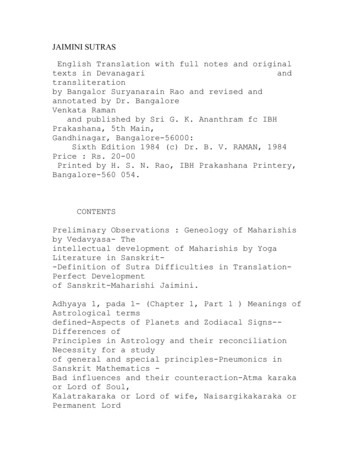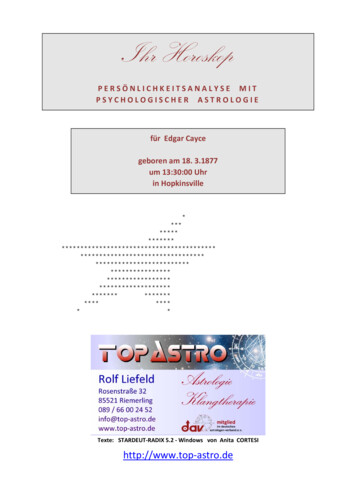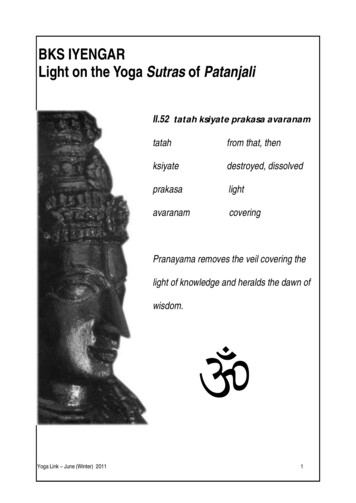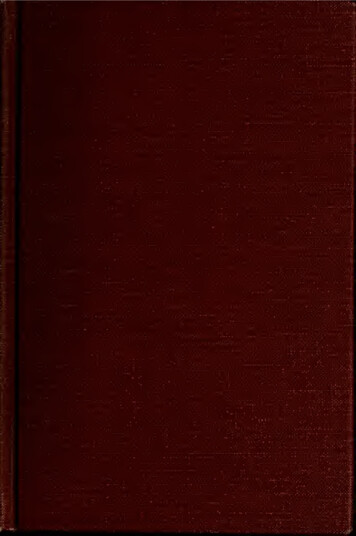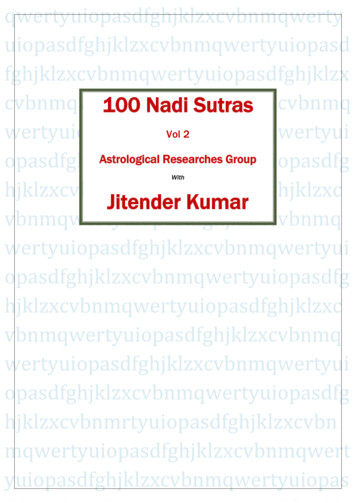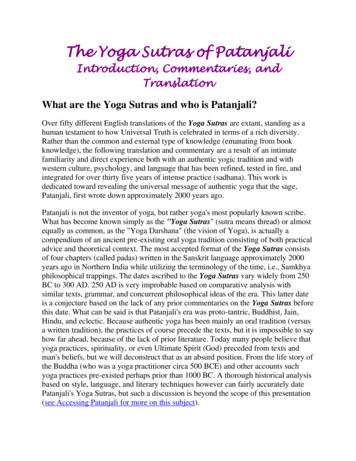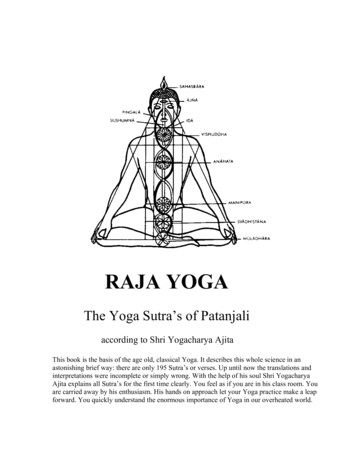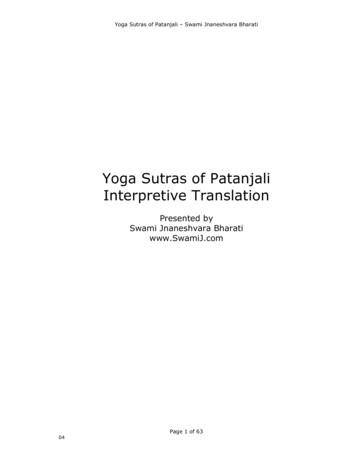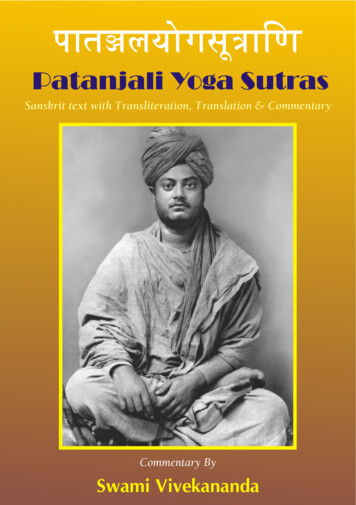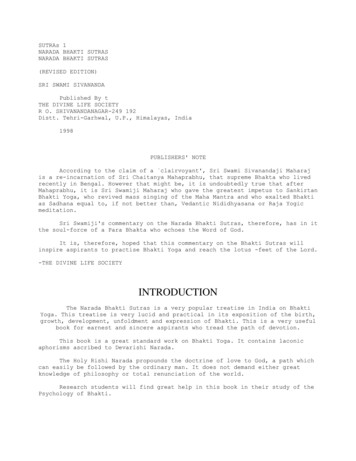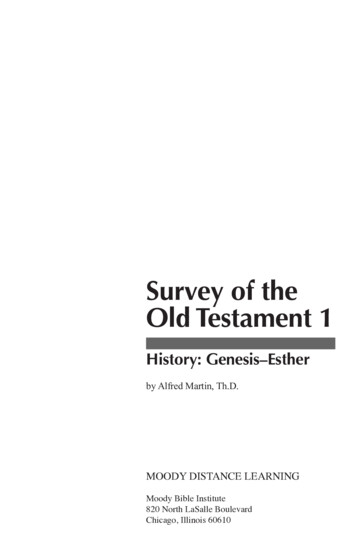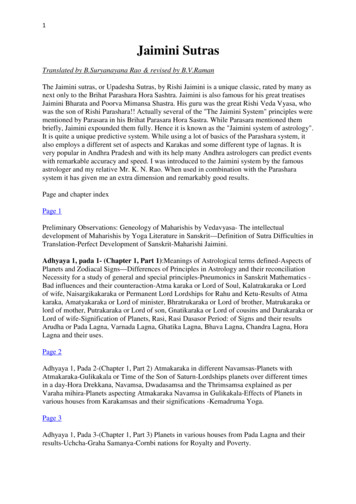
Transcription
1Jaimini SutrasTranslated by B.Suryanayana Rao & revised by B.V.RamanThe Jaimini sutras, or Upadesha Sutras, by Rishi Jaimini is a unique classic, rated by many asnext only to the Brihat Parashara Hora Sashtra. Jaimini is also famous for his great treatisesJaimini Bharata and Poorva Mimansa Shastra. His guru was the great Rishi Veda Vyasa, whowas the son of Rishi Parashara!! Actually several of the "The Jaimini System" principles werementioned by Parasara in his Brihat Parasara Hora Sastra. While Parasara mentioned thembriefly, Jaimini expounded them fully. Hence it is known as the "Jaimini system of astrology".It is quite a unique predictive system. While using a lot of basics of the Parashara system, italso employs a different set of aspects and Karakas and some different type of lagnas. It isvery popular in Andhra Pradesh and with its help many Andhra astrologers can predict eventswith remarkable accuracy and speed. I was introduced to the Jaimini system by the famousastrologer and my relative Mr. K. N. Rao. When used in combination with the Parasharasystem it has given me an extra dimension and remarkably good results.Page and chapter indexPage 1Preliminary Observations: Geneology of Maharishis by Vedavyasa- The intellectualdevelopment of Maharishis by Yoga Literature in Sanskrit—Definition of Sutra Difficulties inTranslation-Perfect Development of Sanskrit-Maharishi Jaimini.Adhyaya 1, pada 1- (Chapter 1, Part 1):Meanings of Astrological terms defined-Aspects ofPlanets and Zodiacal Signs—Differences of Principles in Astrology and their reconciliationNecessity for a study of general and special principles-Pneumonics in Sanskrit Mathematics Bad influences and their counteraction-Atma karaka or Lord of Soul, Kalatrakaraka or Lordof wife, Naisargikakaraka or Permanent Lord Lordships for Rahu and Ketu-Results of Atmakaraka, Amatyakaraka or Lord of minister, Bhratrukaraka or Lord of brother, Matrukaraka orlord of mother, Putrakaraka or Lord of son, Gnatikaraka or Lord of cousins and Darakaraka orLord of wife-Signification of Planets, Rasi, Rasi Dasasor Period: of Signs and their resultsArudha or Pada Lagna, Varnada Lagna, Ghatika Lagna, Bhava Lagna, Chandra Lagna, HoraLagna and their uses.Page 2Adhyaya 1, Pada 2-(Chapter 1, Part 2) Atmakaraka in different Navamsas-Planets withAtmakaraka-Gulikakala or Time of the Son of Saturn-Lordships planets over different timesin a day-Hora Drekkana, Navamsa, Dwadasamsa and the Thrimsamsa explained as perVaraha mihira-Planets aspecting Atmakaraka Navamsa in Gulikakala-Effects of Planets invarious houses from Karakamsas and their significations -Kemadruma Yoga.Page 3Adhyaya 1, Pada 3-(Chapter 1, Part 3) Planets in various houses from Pada Lagna and theirresults-Uchcha-Graha Samanya-Cornbi nations for Royalty and Poverty.
2Adhyaya 1, Pada 4-(Chapter 1, Part 4) Upapada Lagna and its results-Combinations forvarious diseases – Children – Death of brothers, sisters-Dumbness, stammering, complexion,religious tendencies, adultery, leadership in community-33 crores of Devatas-Nigraha andAnugraha forms-Mahamantras or good Vedic Secrets-Kshudra Mantras or evil incantation.Page 4Adhyaya 2, Pada 1-(Chapter 2, Part 1). Determination of Longevity-Combinations for Long,Middle and Short lives-Reconciliation of different systems of Longevity-KarakayogasKakshya, Hrasa or reduction or degradation Kakshya Vriddhi or ‘ increase-Dwara Rasi,Dwarabahya Rasi and Pakabhoga Rasis explained -Increase of Life and averting deathViparitas or Perverts in meaning-Karakayogas and Kartari yogas detailed-Three kinds ofLongevities Alpayu, Madhyayu and Purnayu—Explanation and results of Rudra, Maheswaraand Brahma Rasis -Different kinds of Yogas.Page 5Adhyaya 2. Pada 2-(Chapter 2, Part 2) Planets causing Death of Mother and Father in ShoolaDasas-Combinations for deaths due to the displeasure of Governments-Different kinds ofdiseases-Bites of insects and venereal complaints.Adhyaya 2, Pada 3-(Chapter 2, Part 3) 170-180 Sthira Dasas, Navamsa Dasas and PranaDasas detailed-Combinations for deaths of uncles, cousins and other relations in Shoola DasasExplanation Shoola Dasas or periods.Adhyaya 2, Pada 4-(Chapter 2, Part 4) 180-197 Bhoga Rasis, Bhoga Dasas and Paka DasasCombinations for imprisonments and Deaths in Purusha and Stri Rasis-Yogardha Dasa,Drigdasa and Trikona Dasa.
3Page 1PRELIMINARY OBSERVATIONSThe name of Maharishi Jaimini is held in high esteem and reverence among the Sanskritwriters of eminence and probably he is held only next to Maharishi Vedavyasa. Jaimini is thedisciple of Vyasa, and besides being a writer of various treatises and the Epic Jaimini Bharata,he is the famous author of Poorva Mimamsa Sastra, and these able aphorisms in Astrologycalled after his name as the JAIMINISUTRAS. The Maharishis, so far as their intellectualdevelopment was, concerned, stood altogether on a unique pedestal unapproached by anyother authors in the world. They expanded their intellects not by ordinary study, patient labourand devotion but by the mystic processes of Yoga. Thus expanding their mental vision by apeculiar process still unknown to the greatest scholars of the present day, they were able tograsp the causes and effects of the celestial and terrestrial phenomena with the greatest easeand on. a scale of understanding and comprehension of facts at which the present generationsstand surprised and wonderstruck.Take Maharishi Vedavyasa the great grandson of Vasishta, the grandson of Sakti, the son ofParasara and the father of Maharishi Shuka who is held in the highest esteem by the greatRishis themselves for this piety, Brahmagnana, and unalloyed purity of life. Vyasa has written18 Puranas including the Mahabharata, enclosing the immortal Bhagavadgita, great Siddhantaafter his name on Astronomy, several works on Astrology and the most profoundBrahmasutras, called Uttara-Mimamsa. This colossal collection of literature relating to allbranches of human knowledge stands as a monument to the grandeur of his glorious intellectand it will be a real surprise to the cultured public, if any other name in the world could be,compared to this intellectual giant. In addition to all these works, he was able to systematiseand put in proper order the Four Vedas and thus earn the most envious title of Vedavyasa orone who put the Vedas in their present form and sequence. Jaimini was a worthy disciple ofVedavyasa and has bequeathed to humanity, many valuable works among which standforemost Jaimini Bharata, Poorva-Mimamsa and the Jaiminisutras on Astrology.In the various branches of the Sanskrit Sciences the sutras are a wonder of Sanskrit literature.We do not know if there is any other language in this world, which has anything like thesutras. A sutra may thus be defined as the shortest in form with the largest meaning possible.JAIMINISUTRAS ere said t0 have been composed in eight chapters. Though brief, theycontain a large quantity of meaning. Many technicalities are used throughout these sutras andI will try to explain them as best as I could. In translations from a rich and comprehensivelanguage to a poor and ill-equipped tongue, it is extremely difficult to bring out the force, thedignity, the sweetness, the majesty and the flow of the original language. The translators,however learned they may be and however brilliant their intelligence may be, have toremember the great gulf which separates their intelligence with that of the great Maharishiwho is their original author.At best the translator can only explain and illustrate what he understands and conceives to bethe meaning of the original author. It may be the correct interpretation of the author or whatmay have been understood to be the meaning by the translator. In the case of the works of theMaharishis, I may not be very wrong if I say that none of the commentators or the translatorscould ever hope to come up to their standard. However, a man can do at best what he honestlyknows to be the meaning; and I can assure my readers that in the translation of these difficultsutras I have taken the greatest care to bring out the correct meaning of the Maharishi in hisinimitable work the JAIMINISUTRAS. Everyone cannot compose a sutra. A sutra, to be asound one. must have certain characteristic features and unless these conditions are satisfiedthey cannot pass muster under the heading of a sutra. In English, so far as my humbleknowledge and practical experience go, it looks impossible to frame a sutra as the Sanskrit
4authors have composed and conceived it. The defects of languages cannot be set right byordinary men, and it is hopeless to make such attempts.Jaimini, through his great sympathy and love for the people, framed these sutras and theyhave to be interpreted on certain principles, which the Sanskrit writers have laid down for ourguidance and education. The brevity of a sutra is its distinguishing feature, and it can easily becommitted to memory even by the ordinary students. Somehow or other, Sanskrit languageseems to have a close affinity to strengthen and improve memory. Have we ever seen anadvocate or a judge who is able to repeat a few sections of any legal book? Is there anyEnglish knowing person who can repeat a play of Shakespeare or a few pages of anydictionary? In Sanskrit, Dasopanishads are easily committed to memory. There are Dwivedisand Thrivedis who easily commit to memory one, two and three Vedas and repeat them withan ease which surprises the listeners. There are many who have committed to memory theSanskrit lexicon “Amara” and quote its stanzas offhand with the greatest ease. Bhagavata,Bharata, Ramayana and other extensive works are easily committed to memory. Kavyas andNatakas. Epics and Dramas form no exception. Astrological literature, whether it beastronomical calculation or astrological Phalabhaga has been committed to memory and I canrepeat more than 2 or 3 thousand slokas, without any paper or pencil.The discussion of thelearned Brahmin Pandits is a source of great delight to the audience. They bring neitherbooks, nor notes, nor papers, nor any references when they come for great assemblies wheretheir knowledge in the several branches of Sanskrit will be tested and where they receive duerewards. The greatest Indian Pandit has hardly anything which deserves the name of a library,whereas the poorest equipped English reader keeps up a decent library. Are not then the headsof these Pandits more valuable than the heads of the greatest English scholars who have torefer to books for constant renewal of their memories?ADHYAYA 1-PADA 1SU. 1.- Upadesam vyakhyasyamah. I shall now explain my work for the benefit of the readersand shall give them proper instructions to understand the subject.NOTES Upadesa means literally bringing one close to the object and make him understandthe truth. Upa samip disanti cause to sit-taking one close to the true object of his search,making him sit there and see clearly with his mental vision, the truths of the Science. Jaiminiobserves that he will take the subject of Astrology in Phalabhaga or Predictive portion,introduce the readers and disciples to the principles of Astrology and make them see the truthsand realise their grandeur by personal experiences. He expands the subject in his owninimitable style and tries his best to put vast quantities of Astrological knowledge in thefewest possible Aphorisms called the Sutras. This word Upa occurs in Upanayana as making aman, see the grandeur of Parabrahma, and Upanishad or taking one nearer to God andUpasana carrying the same idea and making the person see the object of his search and bringhim into closer contact with it.SU. 2.-Abhipasyanti rikshani. The zodiacal signs aspect each other (in their front).SU. 3.-Parswabhe cha. Excepting. the next zodiacal signs to them.SU. 4.- ?ihann ishthascha tadvat. Those planets which occupy such signs will also aspect theplanets found in such houses.NOTES Unless easy explanations are offered and illustrations are given the meanings of theseSanskrit Sutras will not become intelligible and convincing to the readers. The second Sutracan be explained thus. The zodiacal signs aspect each other which are in their front. I do notexactly understand what is meant by the word front. The commentators who have doneinvaluable services to humanity by their lucid explanations and the removal of all reasonabledoubts thus observe : Mesha has Vrischika, Vrishabha has Thula, Mithuna has Kanya, Katakahas Kumbha, Simha has Makara, Kanya has Dhanus, Thula has Vrishabha. Vrischika hasMesha, Dhanus has Meena, Makara has Simha, Kumbha has Kataka and Meena has Mithuna
5as the signs in front and aspect them.From the 3rd sutra it is signified that the zodiacal sign next to Aries, viz., Vrishabha is notaspected, the sign Mithuna is not aspected by Vrishabha, Kataka is not aspected by Mithuna,Simha is not aspected by Kataka and so forth. Following this rule alt the Chara Rasis ormovable signs aspect all the Sthira Rasis or fixed signs excepting that which is next to it andall the fixed signs aspect the movable signs excepting that which is next to it. The doublebodied signs aspect each other. In none of the current astrological books is mentioned the factof the aspecting of zodiacal signs or the planets which are in them in this particular manner. Inthe 4th sutra, reference is made to planets occupying those houses, and exercising aspectualinfluences as the houses themselves are said to do. I will give a few illustrations to exemplifythe above enunciated principles. Meena Mesha Vrishabha Mithuna Kumbha I Kataka IDIAGRAM I Makara j Simha Dhanus Vrischika Thula Kanya*Chara Rasis aspect Sthira Rasis, Sthira Rasis aspect Chara Rasis and Dwiswabhava Rasisaspect the Dwiswabhavas. Mesha is movable and Vrishabha next to it is fixed Mesha is saidto aspect the fixed signs except the one which is next to it. Mesha aspects the fixed signsSimha, Vrischika and Kumbha but not Vrishabha, which is c
next only to the Brihat Parashara Hora Sashtra. Jaimini is also famous for his great treatises Jaimini Bharata and Poorva Mimansa Shastra. His guru was the great Rishi Veda Vyasa, who was the son of Rishi Parashara!! Actually several of the "The Jaimini System" principles were mentioned by Parasara in his Brihat Parasara Hora Sastra. While Parasara mentioned them
